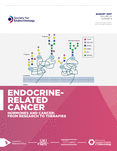WOMEN IN CANCER THEMATIC REVIEW: New roles for nuclear receptors in prostate cancer
- Division of Cancer, Imperial Centre for Translational & Experimental Medicine, Imperial, College London, Hammersmith Hospital Campus, London, UK
- Correspondence should be addressed to C L Bevan; Email: charlotte.bevan{at}imperial.ac.uk
Abstract
Prostate cancer has, for decades, been treated by inhibiting androgen signalling. This is effective in the majority of patients, but inevitably resistance develops and patients progress to life-threatening metastatic disease – hence the quest for new effective therapies for ‘castrate-resistant’ prostate cancer (CRPC). Studies into what pathways can drive tumour recurrence under these conditions has identified several other nuclear receptor signalling pathways as potential drivers or modulators of CRPC.
The nuclear receptors constitute a large (48 members) superfamily of transcription factors sharing a common modular functional structure. Many of them are activated by the binding of small lipophilic molecules, making them potentially druggable. Even those for which no ligand exists or has yet been identified may be tractable to activity modulation by small molecules. Moreover, genomic studies have shown that in models of CRPC, other nuclear receptors can potentially drive similar transcriptional responses to the androgen receptor, while analysis of expression and sequencing databases shows disproportionately high mutation and copy number variation rates among the superfamily. Hence, the nuclear receptor superfamily is of intense interest in the drive to understand how prostate cancer recurs and how we may best treat such recurrent disease. This review aims to provide a snapshot of the current knowledge of the roles of different nuclear receptors in prostate cancer – a rapidly evolving field of research.
- androgen receptor
- endocrine therapy resistance
- estrogen receptor
- gene transcription
- prostate
- coactivator
- corepressor
- Received 12 September 2016
- Accepted 19 September 2016
- Made available online as an Accepted Preprint 19 September 2016
- © 2016 Society for Endocrinology












